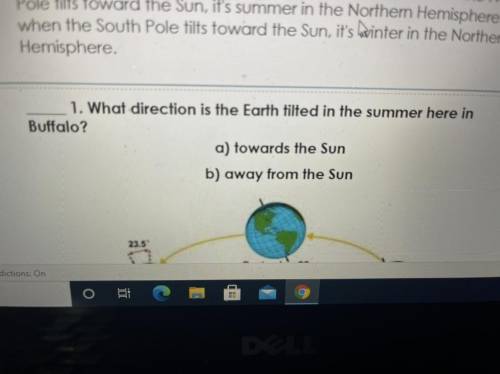The Short
Earth's tilted axis causes the seasons. Throughout the year, different
parts of Ea...

Physics, 11.02.2021 01:50 spiderman66
The Short
Earth's tilted axis causes the seasons. Throughout the year, different
parts of Earth receive the Sun's most direct rays. So, when the North
Pole tilts toward the Sun, it's summer in the Northern Hemisphere. And
when the South Pole tilts toward the Sun, it's qvinter in the Northern
Hemisphere.
1. What direction is the Earth tilted in the summer here in
Buffalo?
a) towards the Sun
b) away from the Sun
23.5


Answers: 3


Other questions on the subject: Physics


Physics, 22.06.2019 09:00, cmflores3245
Sobre transformações cíclicas, são feitas algumas afirmações, determine quais estão corretas. i – a variação de energia interna em uma transformação cíclica é nula; ii – o trabalho, em uma transformação cíclica, é sempre positivo; iii – ao completar um ciclo, o gás tem a mesma temperatura com a qual começou a transformação; iv – uma transformação cíclica é, obrigatoriamente, composta de transformações conhecidas, como adiabática, isocórica, etc: a) i e iii b) i e ii c) ii e iii d) i e iv e) iii e iv
Answers: 1

Physics, 22.06.2019 20:30, Taylor129
Which statement best describes the direction of the buoyant force on any object? a. opposite the force of gravity b. in the same direction as the weight c. in the direction of motion of the object d. opposite the direction of motion of the object
Answers: 1

Physics, 22.06.2019 20:50, dorkygirl
An ideal otto cycle has a compression ratio of 8. at the beginning of the compression process, air is at 95 kpa and 27°c, and 750 kj/kg of heat is transferred to air during the constant-volume heat-addition process. assuming constant specific heats at room temperature, determine (a) the pressure and temperature at the end of the heat-addition process, (b) the net work output, (c) the thermal efficiency, and (d) the mean effective pressure for the cycle. (4390 kpa, 1730 k; 423 kj/kg; 56.4%; 534 kpa)
Answers: 1
You know the right answer?
Questions in other subjects:



History, 21.04.2021 19:00





Mathematics, 21.04.2021 19:00


Mathematics, 21.04.2021 19:00



